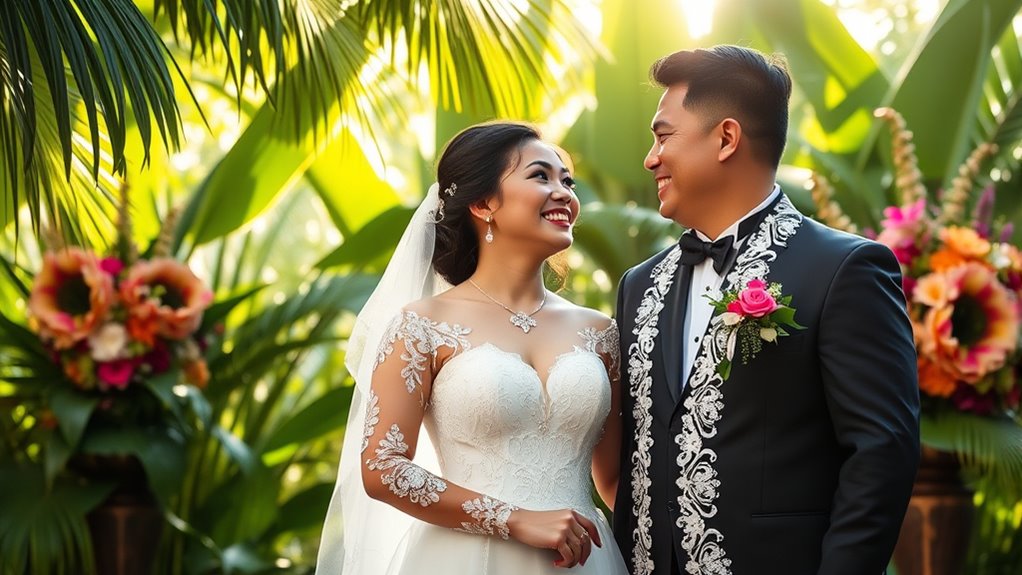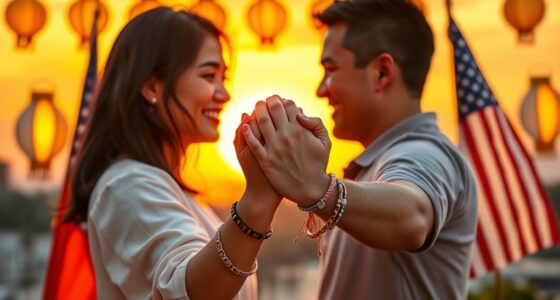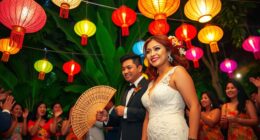You met on a dating app, sparking an incredible journey between cultures. Through modern technology, you bridged gaps and celebrated your love, embracing Filipino traditions like pamamanhikan and unity rituals. Choosing the perfect venue in Tagaytay added charm to your wedding, while attire like the Barong Tagalog and Filipiniana showcased cultural pride. You honored family and community, engaging in meaningful rituals. Every moment was woven with love and heritage. Discover how these experiences shaped your beautiful wedding story.
Key Takeaways
- We met through FilipinoCupid, which facilitated our intercultural relationship with advanced matching algorithms and safety features.
- Embracing Filipino traditions, like pamamanhikan and wearing Barong Tagalog, strengthened our bond and showcased cultural pride.
- Choosing a wedding venue in Tagaytay balanced accessibility and natural beauty, enhancing our celebration.
- Incorporating symbolic rituals, such as the exchange of arras coins, emphasized our commitment and unity as a couple.
- Family engagement in our wedding rituals fostered community support and honored our cultural heritage, enriching our shared experience.
How We Met on a Dating App

When I first downloaded a dating app, I never expected to meet someone who’d change my life. I chose FilipinoCupid, drawn by its reputation for connecting foreigners with Filipinas.
Discovering love on FilipinoCupid was an unexpected journey that transformed my life forever.
The app’s advanced matching algorithms and safety features made me feel secure as I explored potential connections. I appreciated how the platform incorporated Filipino cultural nuances, enhancing compatibility.
As I swiped through profiles, I stumbled upon hers, and it felt like fate. We shared common interests and values, which made our conversations flow effortlessly.
Before long, our virtual chats turned into something deeper. It wasn’t just a fleeting encounter; it was the beginning of a beautiful relationship, fueled by the opportunities that modern technology provided.
Bridging Cultural Gaps Through Modern Technology

The journey from a dating app to a wedding showcases how modern technology can bridge cultural gaps. You’ll find that dating apps connect people across cultures, fostering intercultural marriages that enrich both families. As you navigate planning your wedding, platforms like Instagram and Facebook help exchange ideas and traditions, blending Filipino and Western influences. Digital tools streamline logistics, making it easier to incorporate traditional elements like the veil and cord ceremonies alongside modern practices. Moreover, understanding the importance of clear communication can enhance the planning process and ensure that both partners feel valued. Additionally, effective communication strategies can help navigate potential misunderstandings that arise during the planning process. Research indicates that astrological compatibility may enhance interpersonal attraction, which can be beneficial as couples plan their lives together. successful co-parenting tips can be beneficial when blending families post-wedding, fostering a supportive environment for children. You can even share your unique wedding story online, inspiring others to embrace cultural roots. While technology enhances accessibility, it’s essential to balance modernity with cultural sensitivity, ensuring that the significance of traditions remains intact. Additionally, understanding the impact of limits on creativity can lead to more innovative and personalized wedding ideas. Ultimately, technology fosters deeper connections and understanding in your intercultural journey.
Embracing Filipino Traditions in Our Relationship
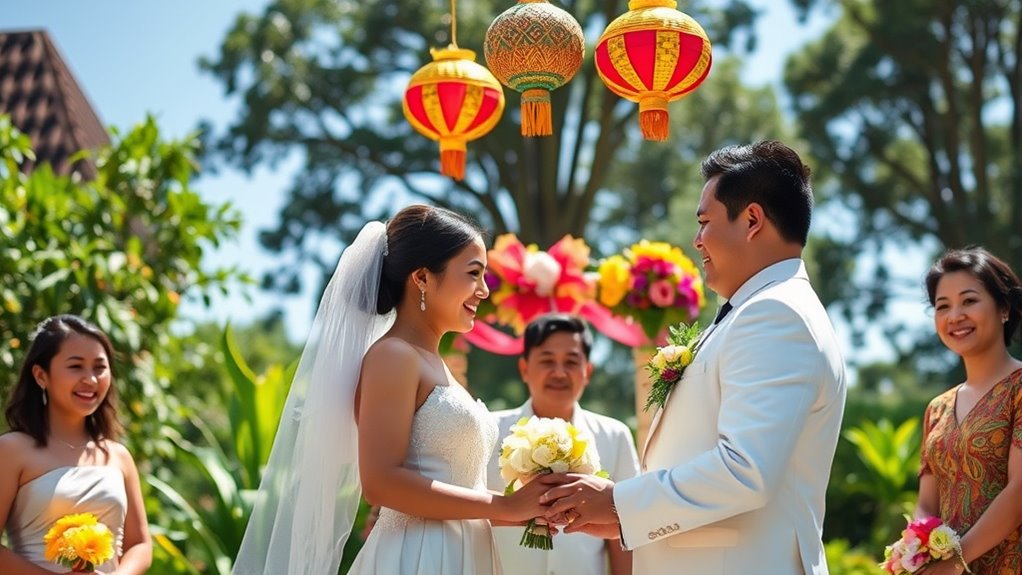
Embracing Filipino traditions in your relationship not only deepens your bond but also honors your cultural heritage.
Participating in the pamamanhikan, where your families formally unite, sets a strong foundation for your future.
Wearing the Barong Tagalog and Filipiniana during significant events showcases your pride in these customs.
Incorporating unity symbols like the veil and cord during your ceremony emphasizes the eternal commitment you share.
Engaging your families in blessings and rituals, like the Arras ceremony, reflects the community spirit that defines Filipino weddings.
Choosing the Perfect Venue for Our Wedding
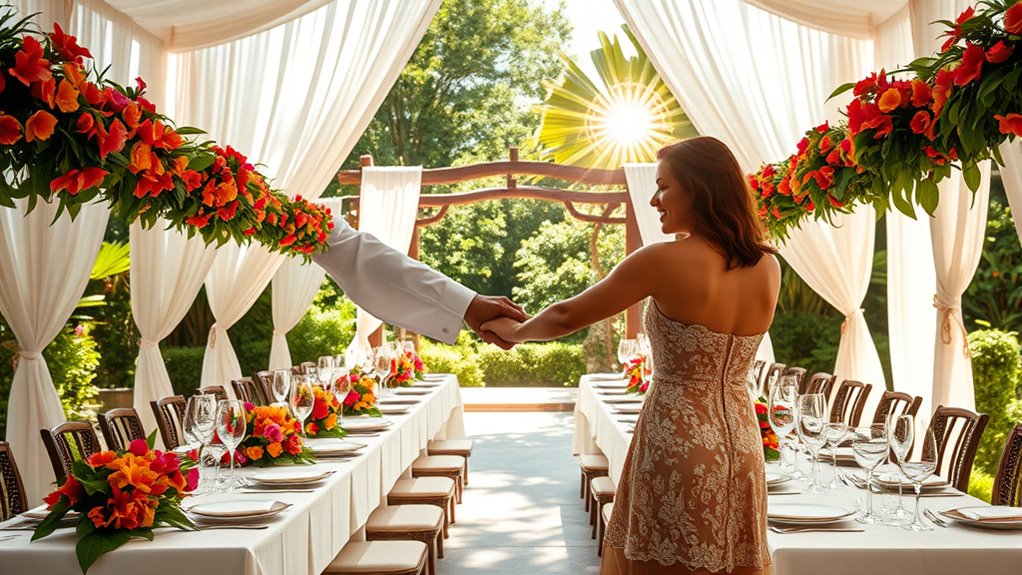
Choosing the perfect venue for your wedding can feel overwhelming, especially with so many beautiful options across the Philippines.
Start by considering the location and accessibility; places like Tagaytay offer easy travel from Manila. Many couples also appreciate the option of hotels with water parks for their guests’ entertainment, providing a fun way to relax and enjoy the festivities.
Consider the location and accessibility of your venue; Tagaytay offers convenient travel from Manila for your special day.
Think about the natural beauty you want—beachfront resorts in Boracay or tranquil mountain retreats can set the right mood. Cultural festivals in the area may also enhance your wedding atmosphere. Additionally, consider venues that might offer hydrotherapy options for a unique and relaxing experience for you and your guests.
Reflect on your guest list as venues vary from intimate settings to grand spaces.
Don’t forget to align your choice with local customs for a richer experience.
Budget’s also essential, as costs depend on location and amenities.
Explore options with catering, accommodations, and recreational activities that keep guests entertained.
Ultimately, the venue should reflect your style and create unforgettable memories. Additionally, consider natural wonders and outdoor activities that may complement your wedding festivities.
Selecting Traditional Attire: Barong Tagalog and Filipiniana
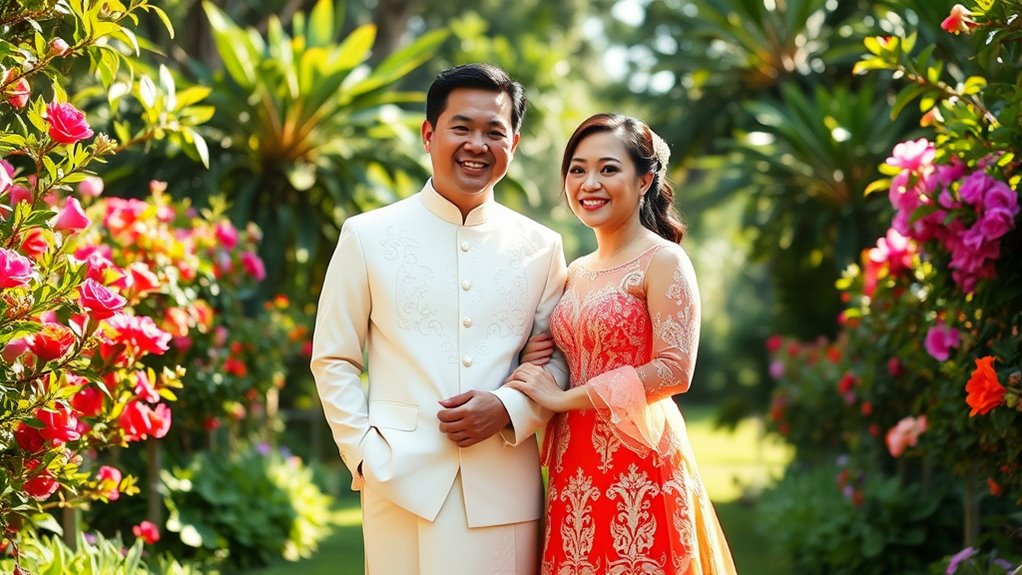
After selecting the perfect venue, it’s time to think about what you’ll wear on your special day. The Barong Tagalog for men and the Filipiniana dress for women are both stunning choices that showcase Filipino culture.
The Barong, made from lightweight fabrics like piña and abaca, adds a unique touch to your wedding, blending history with modern elegance. For women, the Filipiniana, characterized by butterfly sleeves and intricate embroidery, represents tradition and grace.
Both outfits not only reflect your cultural heritage but also encourage your guests to join in the celebration. With numerous design options available, you can find a style that feels both personal and meaningful, ensuring your attire honors your roots beautifully on this special occasion.
Incorporating Pre-Colonial Rituals Into Our Ceremony
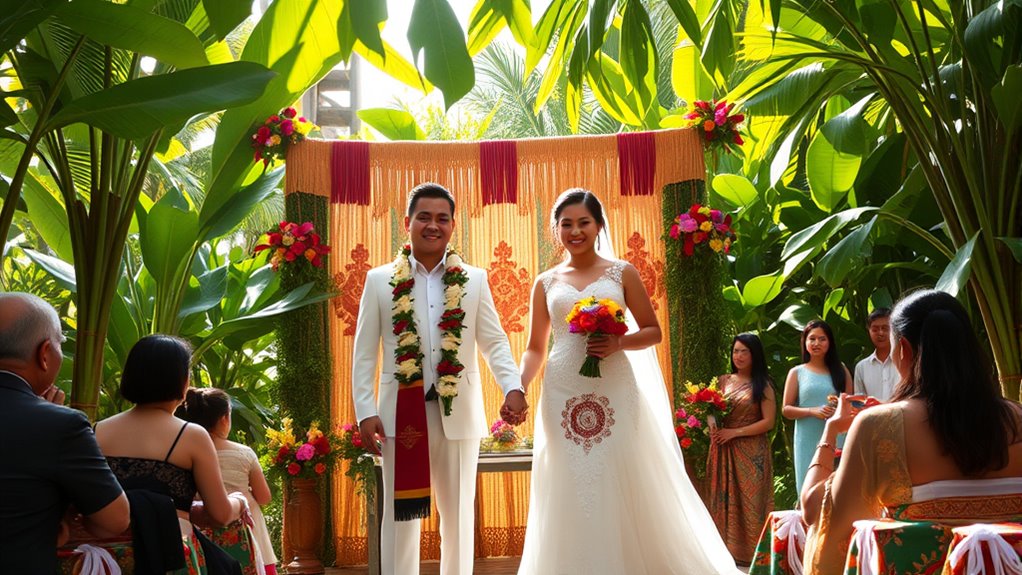
While planning your wedding, you might consider incorporating pre-colonial rituals that honor your Filipino heritage and deepen the meaning of your ceremony.
Start with a blessing from a babaylan, the shaman who symbolizes spiritual authority. This can take place at their home, merging the couple’s families.
You might perform the traditional act of crossing your arms over a bowl of raw rice, receiving blessings of unity.
Consider a ritual where you mix blood with water, representing strength in marriage.
To symbolize eternal fidelity, bind your hands and necks with ropes, echoing the ancient practices.
These elements not only enrich your ceremony but also connect you deeply to your cultural roots, celebrating unity and commitment.
The Significance of the Veil and Cord Ceremony
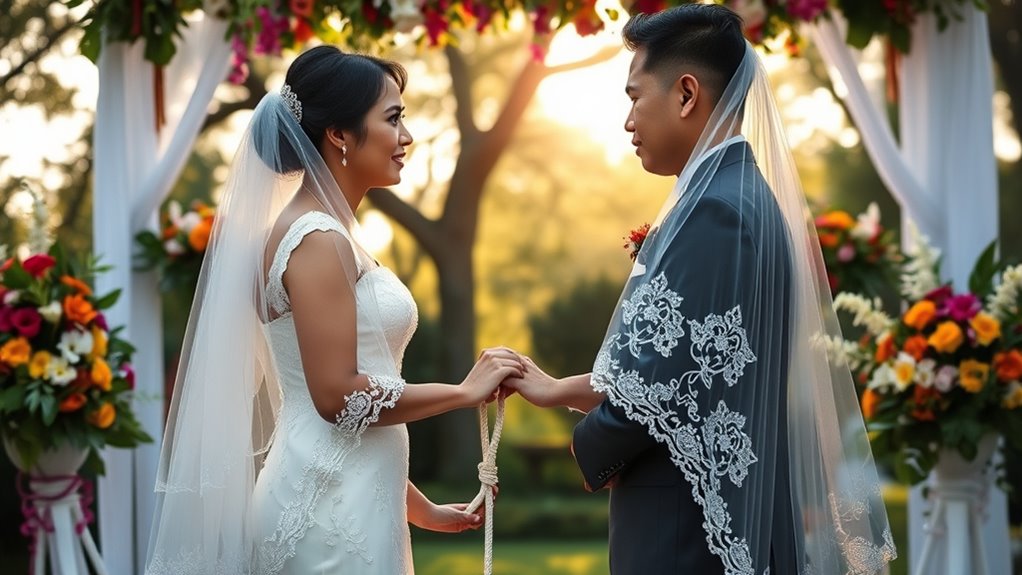
The veil and cord ceremony holds profound significance in Filipino weddings, symbolizing the couple’s unity and eternal bond.
During the ceremony, the veil is placed over your heads, representing the love and protection that will surround you throughout your marriage. This ritual often involves *Ninongs* and *Ninangs*, respected figures chosen for their strong marriages, who help place the veil and cord, symbolizing their guidance and support.
The cord, typically made from silk or satin, loops around your shoulders in a figure-eight shape, emphasizing your commitment to each other.
These traditions, rooted in Catholic and Spanish influences, highlight the importance of faith and cultural heritage in your journey together, reminding you of the deep connection you share. Additionally, the community property laws in various cultures can influence couples’ perceptions of marriage and unity, reflecting the importance of shared assets in their lives.
The Exchange of Arras: A Symbol of Commitment
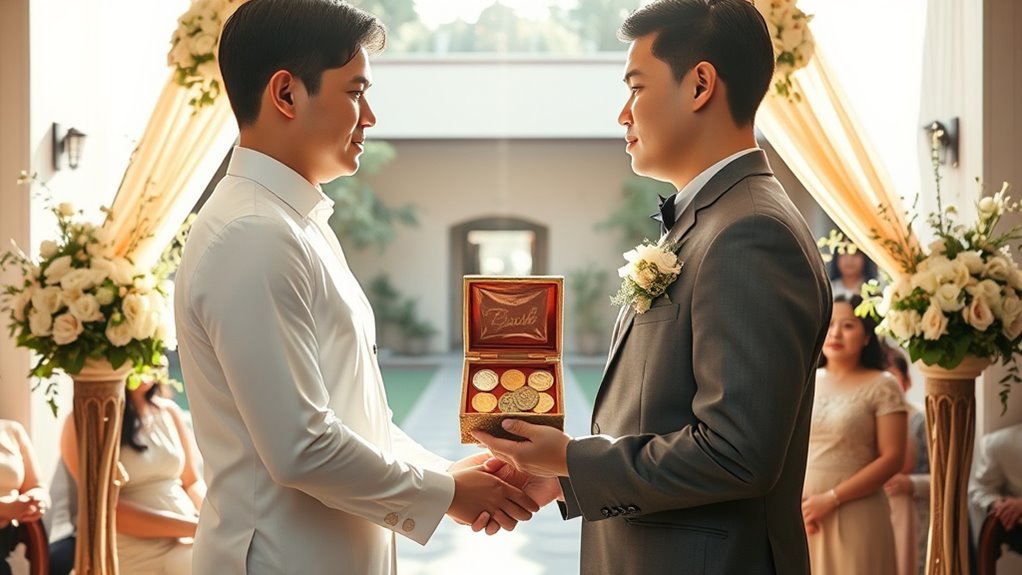
As you stand before your loved ones, the exchange of arras coins becomes a poignant moment in your wedding ceremony, embodying your commitment to one another.
This tradition, rooted in Hispanic and Filipino cultures, symbolizes your promise to share resources and responsibilities. As you hold the 13 coins—representing Jesus and his apostles—you acknowledge the vows you make today.
The officiant blesses the coins, and you and your partner exchange them, a physical representation of your dedication to mutual support. In this ritual, you emphasize your commitment to teamwork and unity, transcending financial circumstances.
The arras ceremony enriches your wedding, honoring cultural heritage while reinforcing the foundation of your life together.
Celebrating With Family and Community
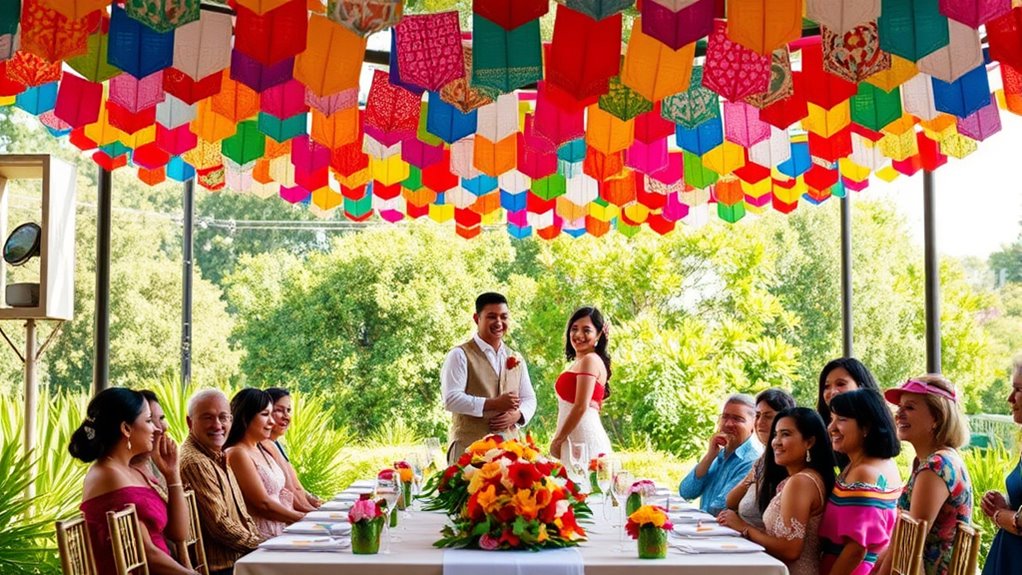
Celebrating your wedding with family and community enhances the significance of your union, turning the event into a vibrant tapestry of love and tradition.
Through the Pamamanhikan, your families formally connect, fostering support and excitement. Involving family members as sponsors and participants in rituals strengthens those bonds, while traditional attire pays homage to your Filipino heritage.
Community engagement shines through shared meals, cultural dances like Tinikling, and honoring elders, creating a warm atmosphere of unity.
Blessing ceremonies and unity rites deepen the spiritual connection, ensuring your marriage is rooted in cultural significance.
Post-Wedding Festivities and Cultural Traditions

While weddings mark the beginning of a couple’s journey together, the post-wedding festivities and cultural traditions continue to weave their shared story within the community.
You’ll find yourself enveloped in vibrant celebrations, starting with the money dance, where guests pin money onto your clothing, symbolizing support. The release of doves signifies peace and love, while sharing sticky rice as your first meal represents unity.
Traditionally, rice blessed your union, now often replaced with biodegradable confetti. The unity candle ceremony, though not originally Filipino, beautifully merges lives.
Through these rituals, your friends and family actively participate, reinforcing the importance of community as you commence on this new chapter together. These elements reflect the diverse world of halal lifestyles, enriching the cultural significance of your union.
Embrace each moment; they’ll enrich your marriage story.
Frequently Asked Questions
How Did You Choose Your Wedding Date?
When choosing your wedding date, consider the season and its impact on your vision. You might prefer the dry season for sunny outdoor ceremonies or the cozy vibe of the rainy season.
Factor in family schedules and cultural traditions, like avoiding Holy Week.
Don’t forget to assess your budget; off-peak months can save you money.
Finally, guarantee your chosen date maximizes guest attendance, making your day even more special with loved ones around.
What Challenges Did You Face During Wedding Planning?
Planning your wedding felt like organizing a royal event!
You faced the overwhelming task of managing a massive guest list, thanks to family expectations. Your parents insisted on inviting everyone they knew, making it tough to stick to a budget.
You juggled venue selections, vendor coordination, and weather contingencies, all while trying to satisfy cultural traditions.
Balancing personal preferences with familial demands added another layer of complexity, turning the planning process into a whirlwind adventure!
How Did You Involve Both Families in the Planning?
To involve both families in the wedding planning, you should hold regular family meetings to keep everyone informed and aligned.
Share key decisions like guest lists and venues together, ensuring that both sides feel included.
Delegate specific tasks to family members, fostering engagement and responsibility.
Incorporate cultural traditions to enrich the experience, and collaborate on budget planning to share financial responsibilities.
Open communication will help manage expectations and create a harmonious planning process.
What Was Your Favorite Moment From the Wedding?
Your favorite moment from the wedding had to be the veil ceremony.
As you stood there, feeling the weight of tradition, you could sense the unity it represented. Watching your loved ones smile, you felt a surge of joy.
When the rope was placed around you both, it symbolized your everlasting bond, and you couldn’t help but feel grateful for this beautiful experience.
That moment truly captured the essence of your journey together.
How Did You Manage Wedding Expenses?
Steering wedding expenses felt like walking a tightrope, balancing dreams with reality.
You started by setting a clear budget, breaking down costs into essential categories like venue, food, and attire.
You researched vendors, comparing prices and services.
Prioritizing helped you allocate funds wisely, ensuring you didn’t overspend on non-essentials.
Conclusion
From swiping right on a dating app to exchanging vows in a vibrant Filipino wedding, your journey showcases the beautiful blend of modern romance and rich tradition. You’ve bridged cultures and created memories, proving love knows no boundaries. As you embrace the joy of family and community, remember that each moment—from the laughter during the veil ceremony to the warmth of shared arras—reflects the unique tapestry of your love story, woven together in harmony and celebration.
